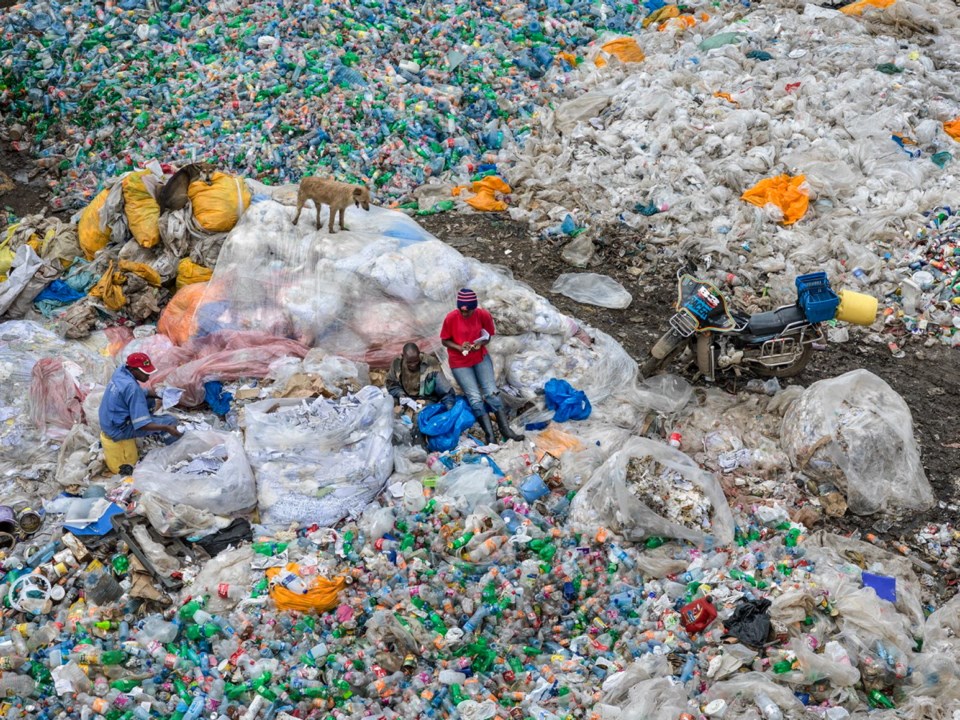What: Anthropocene: The Human Epoch
Where: Cinecenta at the University of Victoria’s Student Union Building
When: Oct. 14 at 3 p.m., 5 p.m., and 7 p.m.; Oct. 15-18 at 7 p.m. and 9 p.m.
Tickets: $5.75
Note: Co-director Jennifer Baichwal will participate in a Q&A session at Cinecenta following the 5 p.m. and 7 p.m. screenings on Oct. 14
A new documentary from a team that includes acclaimed director Jennifer Baichwal looks at the impact modern civilization has had on Earth over thousands of years, and the results aren’t pretty.
There have been significant hydrologic, atmospheric, biospheric and geological shifts during the Holocene period, most of which have been brought about by humankind. The effect on every system of Earth has been profound.
Scientists believe we have moved past the 12,000-year-old Holocene to the Anthropocene, the current geological timescale in which climate change and global warming have become daily concerns.
Terraforming, the act of altering Earth’s surface for human need, forms the framework for Baichwal’s Anthropocene: The Human Epoch. Among some of the film’s most shocking scenes — from the city of Norilsk, Russia’s most polluted city, to Chile’s Atacama Desert, one of the driest places on Earth — are shots of the heavily logged land just outside Port Renfrew.
“We’re all implicated in all of these landscapes,” Baichwal, who was raised in Victoria and graduated from the University of Victoria, said from her home in Toronto.
“But for me, one of the most devastating places [in the film] was Vancouver Island. Growing up there, and having this idea of being surrounded by a kind of primordial nature, reminders of the power of nature … to think there is less than 10 per cent of old-growth forests of Vancouver Island and less than five per cent on southern Vancouver Island is shocking.” By including footage of logging practices on Vancouver Island alongside scenes from the Dandora Landfill in Nairobi, where 6,000 Kenyans make a living from scavenging through the detritus each day, the filmmakers offer a stark statement about the state of the world. Eighty-five per cent of the world’s forests have been degraded for human use, Baichwal said. In B.C., raw log exports have increased exponentially since 2014.
“We’re still cutting old-growth for lumber. We have this completely retrograde, resource-based mentality around the economy [in B.C.].”
There is a glimmer of hope. Constant geological and biological change may not spell the end of our world, but it all comes down to time — and that is running out.
Anthropocene: The Human Epoch, which Baichwal co-directed with her husband, Nicholas de Pencier, and photographer Edward Burtynsky, attempts to give context to this global concept.
“Our goal with this project was to take a word that nobody understands — most people can’t even say it properly — and bring it into the vernacular. The structure of many environmental films I’ve seen over the years, it’s always doom and gloom until the last 10 minutes, and then it goes: ‘But here are the solutions.’ I was trying not to do that. [The film] is hopeful, but I was trying not to do a Band-Aid at the end there.”
The trio responsible for the award-winning documentaries Manufactured Landscapes (2006) and Watermark (2013) have been successful in the past at making planetary destruction accessible for viewers.
In the film, we are introduced to a team of British scientists using a former air-raid shelter from the Second World War to grow organic produce, proving that humans can find new ways of survival in the face of impending destruction. It would be easy to assume that some of these people are stuck in these situations out of desperation and a lack of options. In many cases, Baichwal said, it was a matter of choice. “That’s the point that we’re trying to make,” Baichwal said. “The tenacity and ingenuity that we have used to survive as a species can be turned to save the planet and all life on it. I have no doubt that we have the capacity to do it.”
Baichwal wanted to show what is happening to the planet in places far removed from the day-to-day existence of most people, from potash mines in Russia to phosphate mines in Florida. Production stretched over three years, with shoots in 43 locations in 20 countries on every continent save for Antarctica. Baichwal — who also wrote the voiceover for the film’s narrator, Oscar winner Alicia Vikander — said the team spent a year researching before cameras rolled, and shot 400 hours of footage over two years once the lenses were off.
It took a year of editing by Roland Schlimme (who also has roots in Victoria) to bring the emotional rollercoaster to an end.
“The main goal for us is always to allow you, as a viewer, to experience places you’re connected to, but would never normally see. We went all over the world for this film, and because it was planetary in scope, we needed to go all over the world. And everywhere we went, there was complexity and ambiguity and little moments of hope.”
At various points, Baichwal and de Pencier put filming on hold to co-direct 2017’s Long Time Running, the documentary about the Tragically Hip’s final nationwide tour. Two days after the band’s tour wrapped in 2016, with lead singer Gord Downie battling brain cancer, the couple were back in Russia filming Anthropocene: The Human Epoch.
Baichwal, who was close friends with Downie, remembers being on tour with the Tragically Hip as being “a very intense time, and a beautiful time.” Downie died a month after Long Time Running opened in theatres, but his legacy can be felt throughout Anthropocene: The Human Epoch.
“Gord was an extraordinary person,” Baichwal said.
“Whatever that feeling he created was, and it’s still lingering now, we took it as we went into these other environments with the inspiration of what one person can do. That was a lesson for what we all can do.”

-thumb.png;w=120;h=80;mode=crop)

